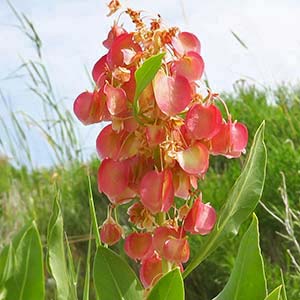Rumex venosus
Rumex transitorius
rumex veine, vein dock, veiny dock, wild-begonia, wing dock
Pacific willow dock, willow dock
ascending or, rarely, erect, usually producing axillary shoots near base, (10–)15–30(–40) cm.
ascending, ascending-decumbent, or erect, simple or producing axillary shoots below 1st-order inflorescence or at proximal nodes, 25–70 cm.
blades ovate-elliptic, obovate-elliptic, or ovate-lanceolate, (2–)4–12(–15) × 1–5(–6) cm, subcoriaceous, base narrowly to broadly cuneate, margins entire, flat or slightly undulate, apex acute or acuminate.
blades linear-lanceolate or lanceolate, 6–15(–17) × 2–4 cm, usually ca. 3.5–6 times as long as wide, widest near middle or nearly so, thin or rarely subcoriaceous, base cuneate, margins entire, undulate or slightly crisped, apex acute.
terminal and axillary, usually occupying distal 2/3 of stem/shoot, usually dense, or interrupted in proximal part, broadly paniculate.
terminal and axillary, terminal usually occupying distal 1/5–1/3 of stem, dense or occasionally interrupted near base, usually broadly paniculate (branches simple or with few 2d-order branches).
articulated near middle, filiform or slightly thickened, (8–)10–16 mm, articulation distinct, slightly swollen.
articulated in proximal 1/3, filiform, 3–7 mm, equaling or 1.5–2 times as long as inner tepals, articulation indistinctly swollen.
5–15 in whorls;
inner tepals distinctly double-reticulately veined, orbiculate or reniform-orbiculate, 13–18(–20) × (20–)23–30 mm, base deeply emarginate or cordate, margins entire, apex rounded, obtuse, rarely subacute, with short, broadly triangular tip;
tubercles absent, occasionally very small.
10–20(–25) in whorls;
inner tepals, broadly ovate to ovate-lanceolate, occasionally almost triangular, (2.5–)3–3.5 × 2–2.5 mm, base truncate or rounded, margins entire or indistinctly erose, apex obtuse or subacute;
tubercles 3 (occasionally 1 in var. monotylos Rechinger f., then very large, subequal or only slightly narrower than inner tepal), distinctly unequal (1 larger tubercle subequal or slightly narrower than inner tepal), usually smooth.
brown or dark brown, 5–7 × 4–6 mm.
dark reddish brown, 1.8–2.4 × 1–1.5 mm.
= 40.
= 20.
Rumex venosus
Rumex transitorius
Rumex venosus is a distinctive species rarely confused with any other members of the genus. However, I have seen herbarium specimens of it misidentified as R. hymenosepalus, and vice versa.
(Discussion copyrighted by Flora of North America; reprinted with permission.)
J. T. Kartesz (1987, vol. 1) reported Rumex transitorius from Washoe County, Nevada; the morphological characters mentioned in his description suggest another taxon of the R. salicifolius aggregate. Records from Idaho also need confirmation.
(Discussion copyrighted by Flora of North America; reprinted with permission.)
- Local floras:
CA,
OR,
WA
- Local Web sites:
CalFlora,
CalPhotos,
Flora NW,
KS Wildflowers,
MN Wildflowers,
PNW Herbaria,
Turner Photog.
WildflowerSearch
iNaturalist (observations)
USDA Plants Database
- LBJ Wildflower Center
- SEINet
- Plants of the World Online
- Encyclopedia of Life
- Wikipedia
- Google Image Search
- Local floras:
BC,
CA,
OR
- Local Web sites:
CalFlora,
CalPhotos,
Flora NW,
PNW Herbaria
WildflowerSearch
iNaturalist (observations)
USDA Plants Database
- LBJ Wildflower Center
- SEINet
- Plants of the World Online
- Encyclopedia of Life
- Wikipedia
- Google Image Search


